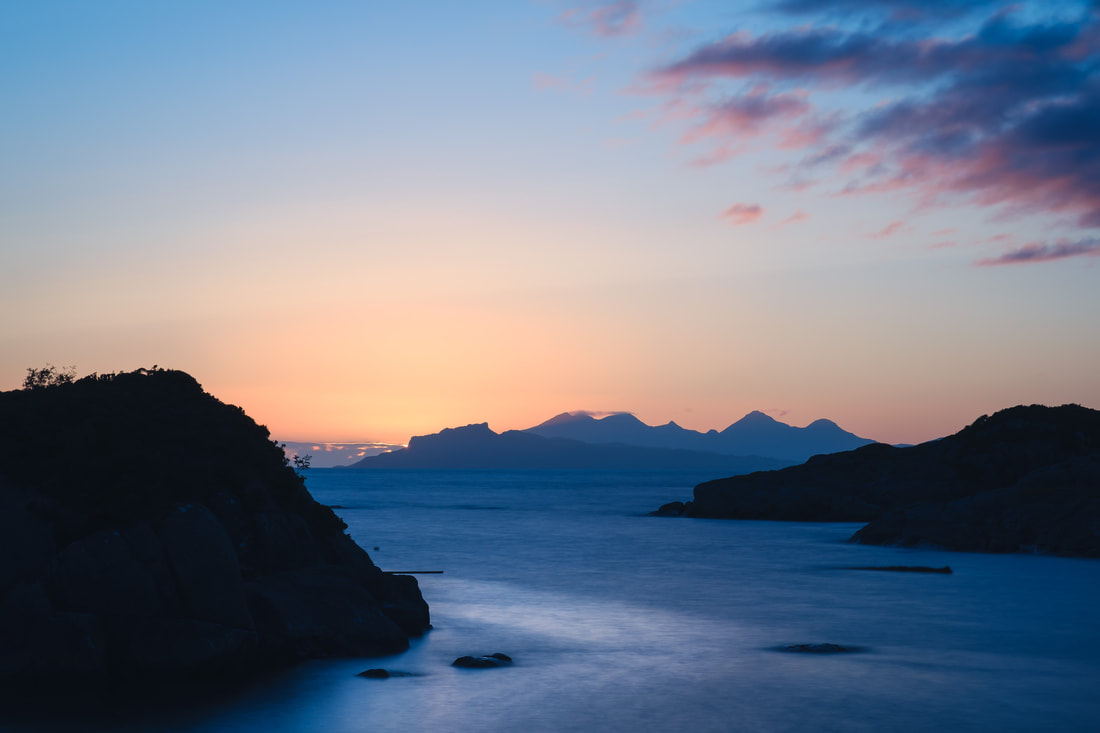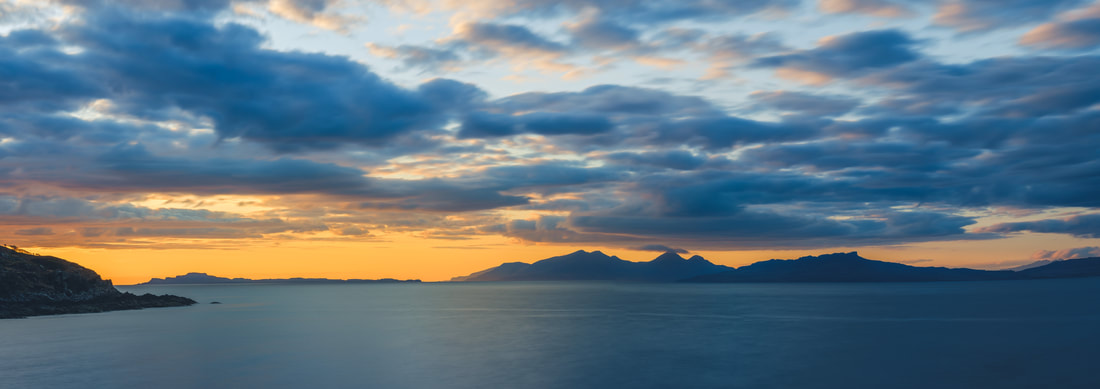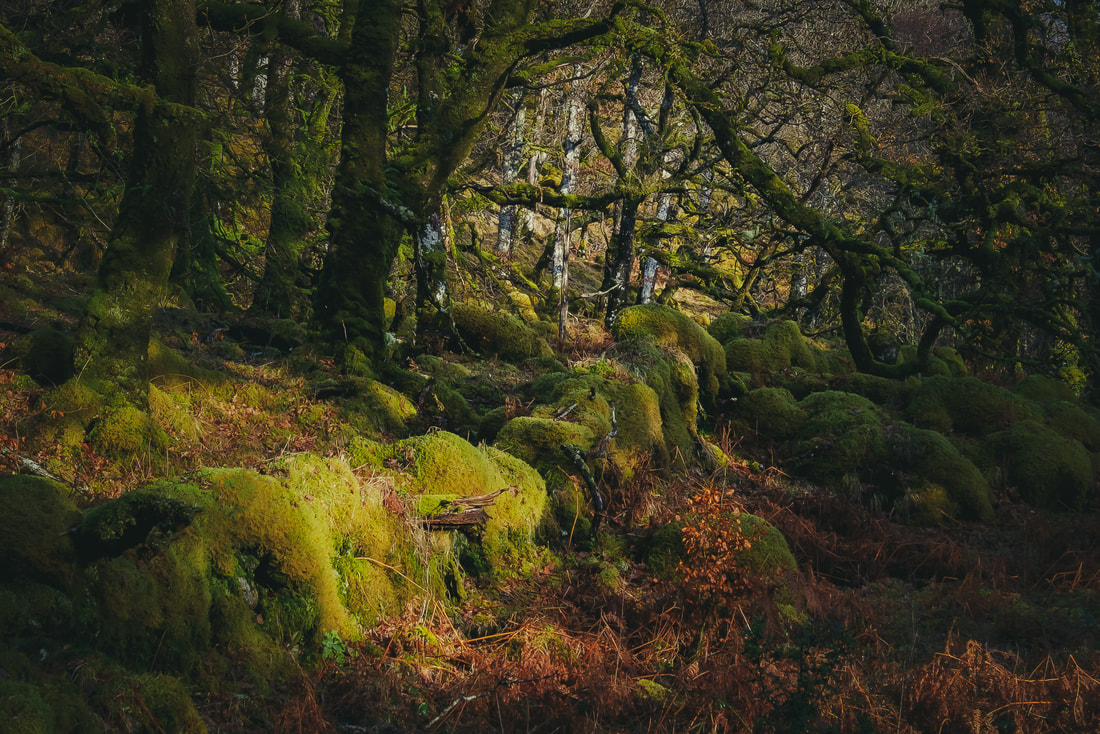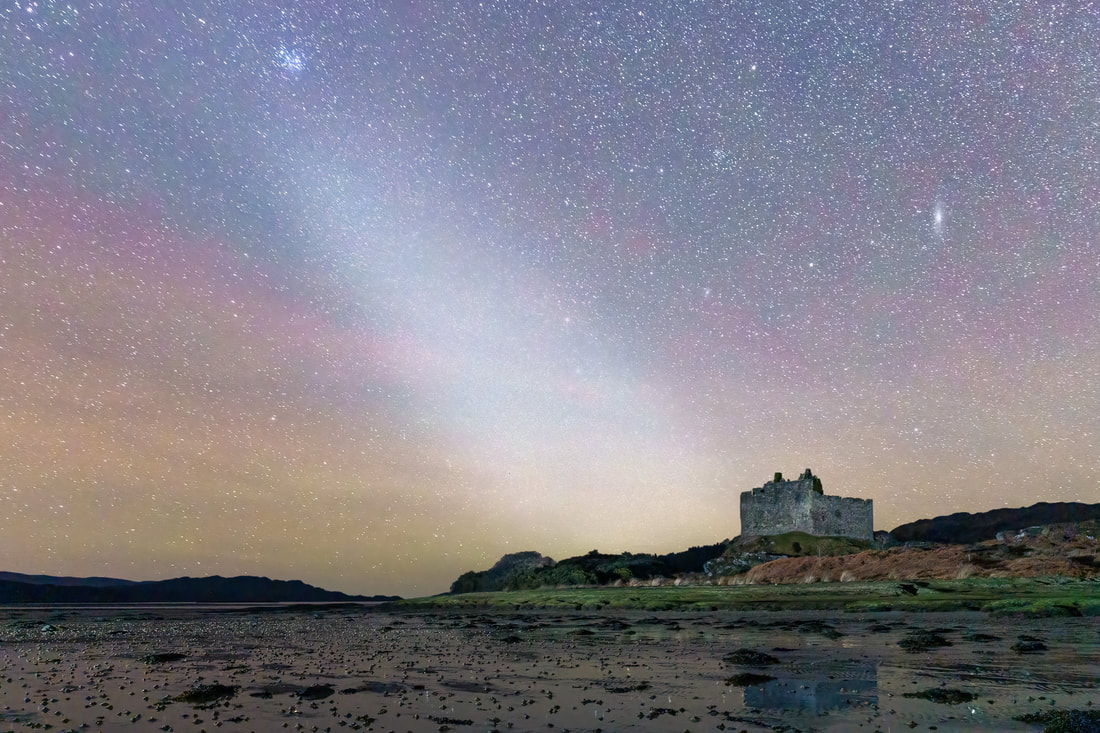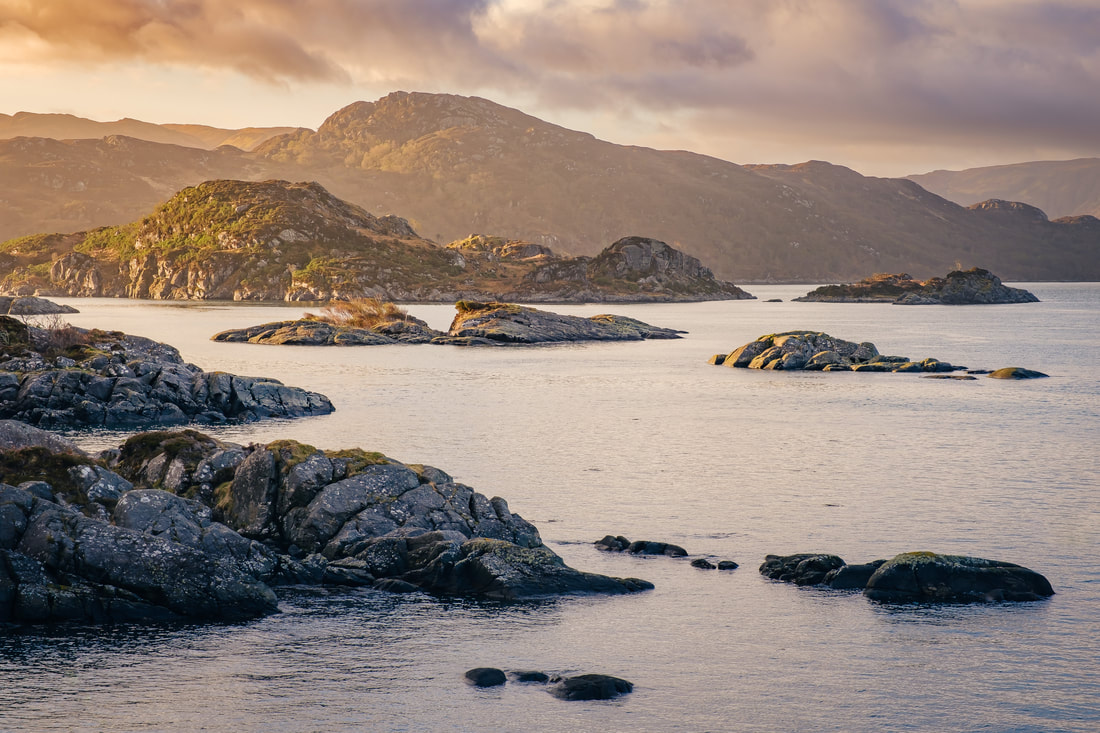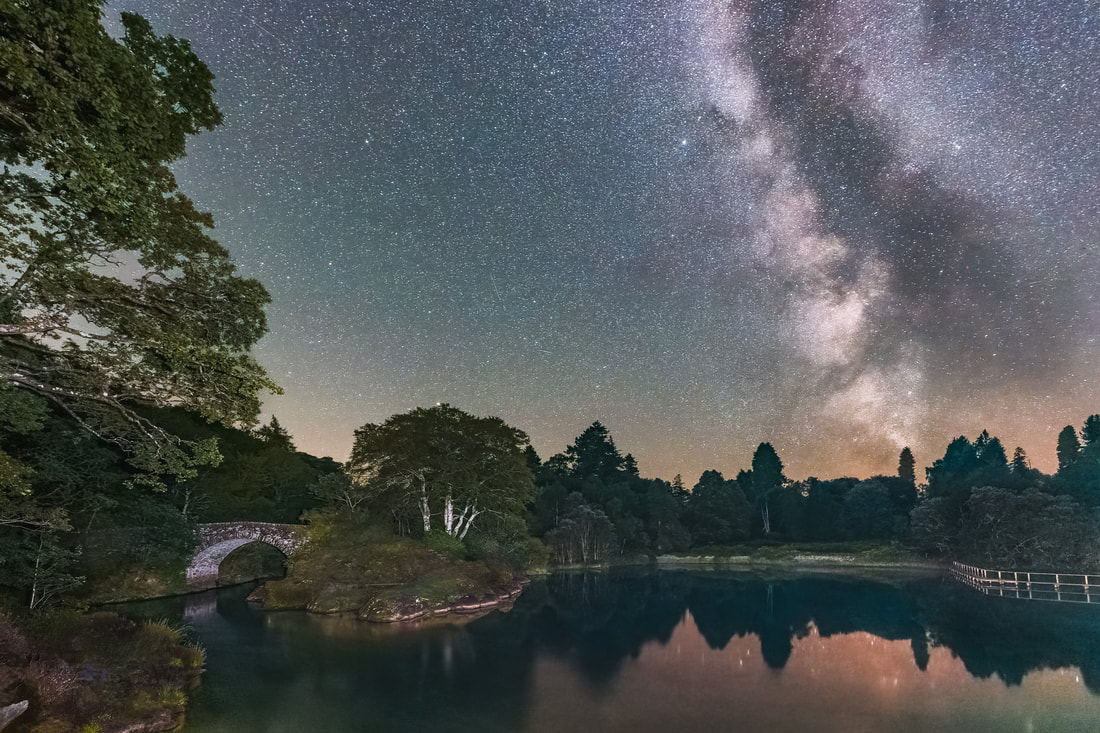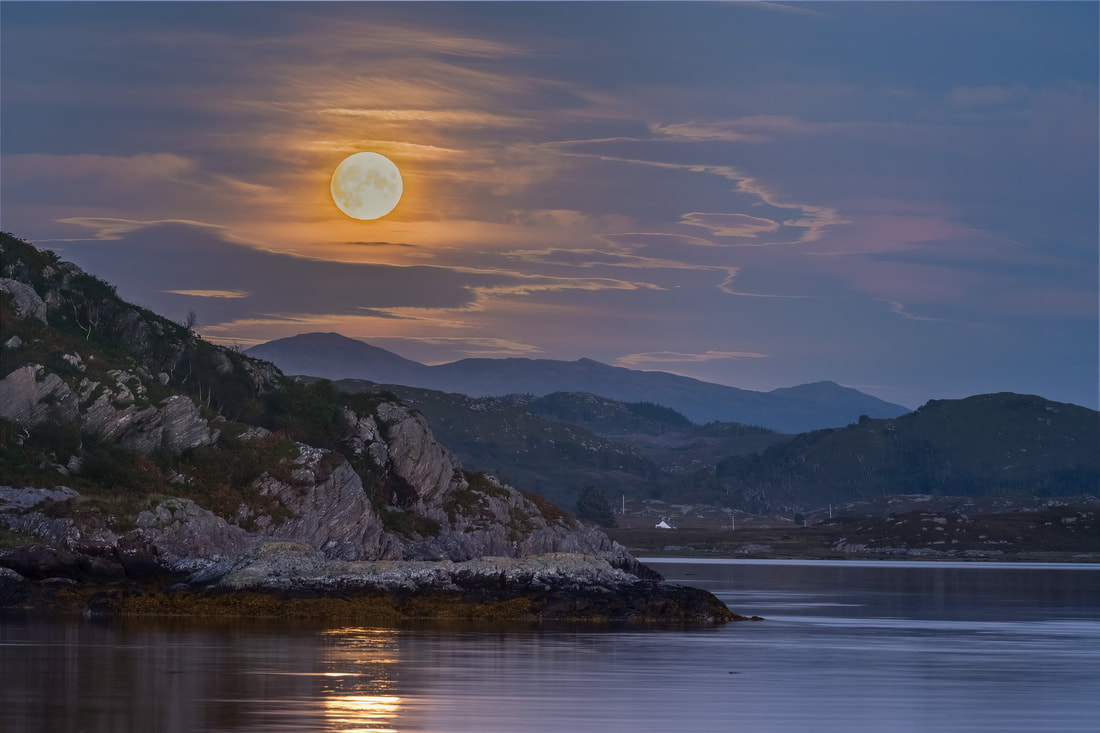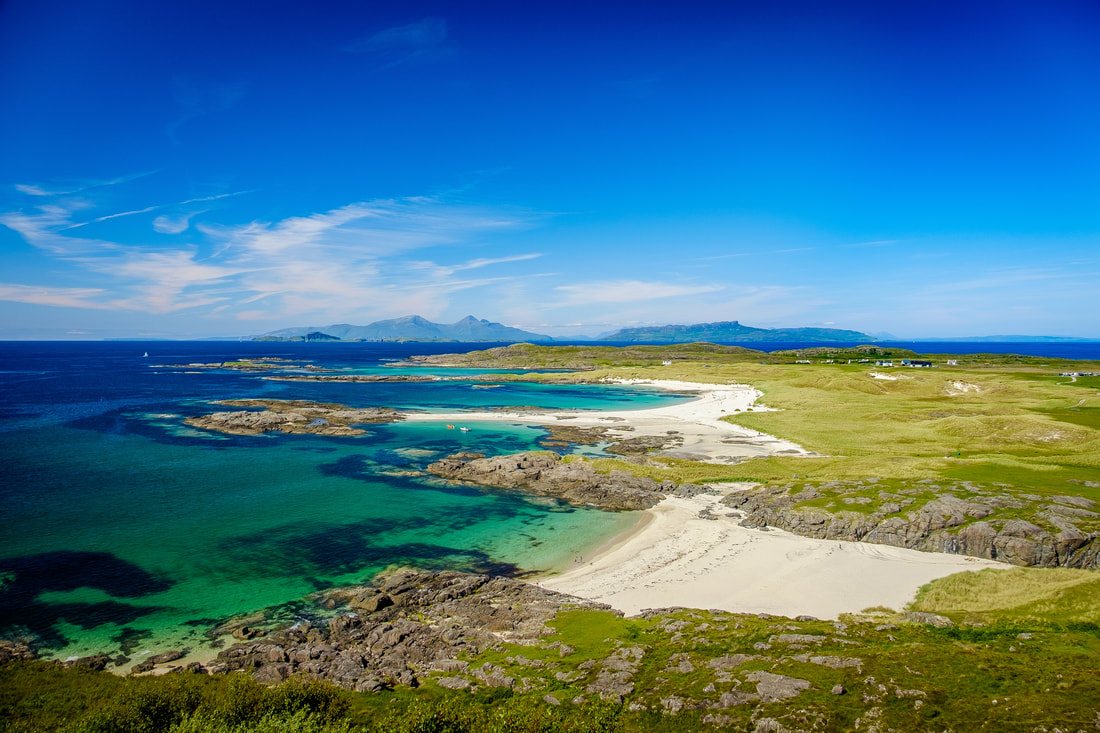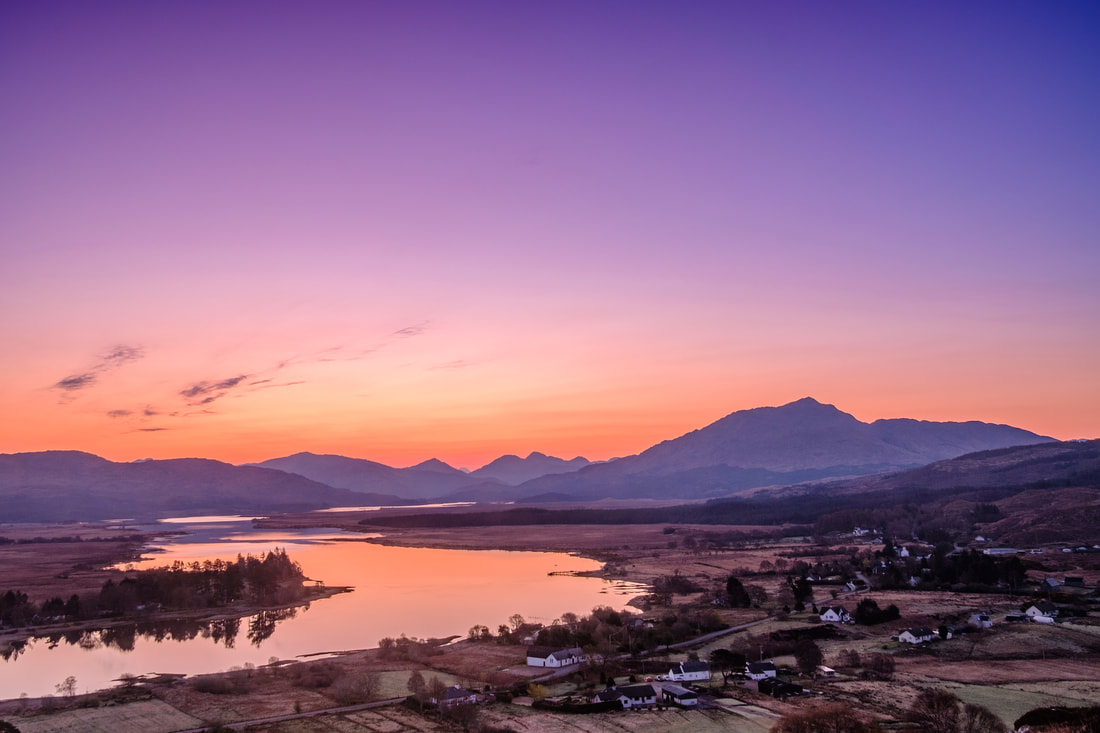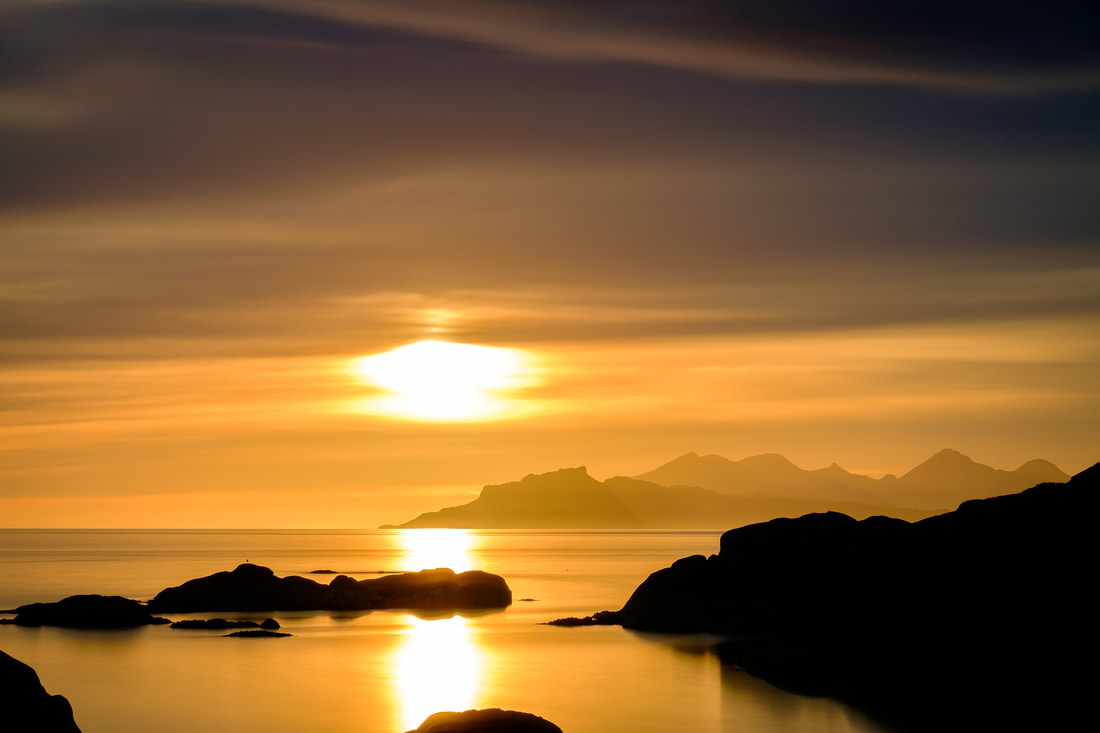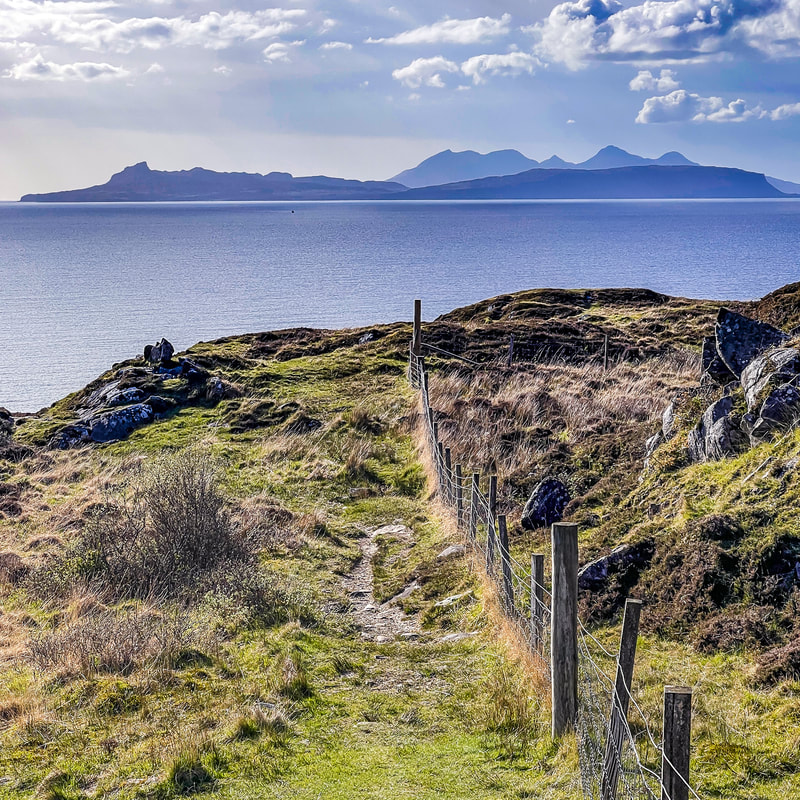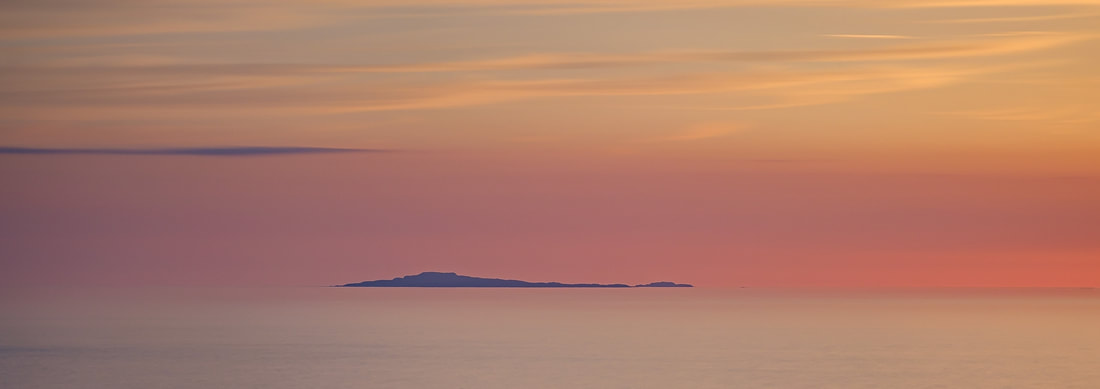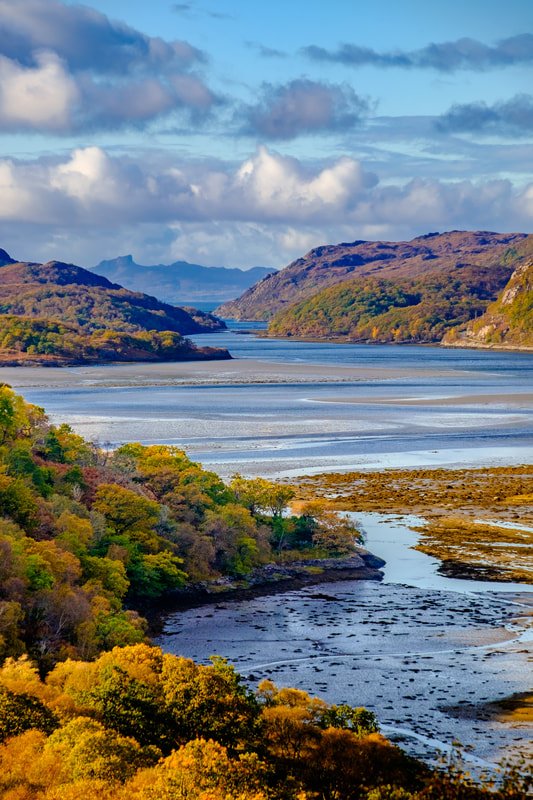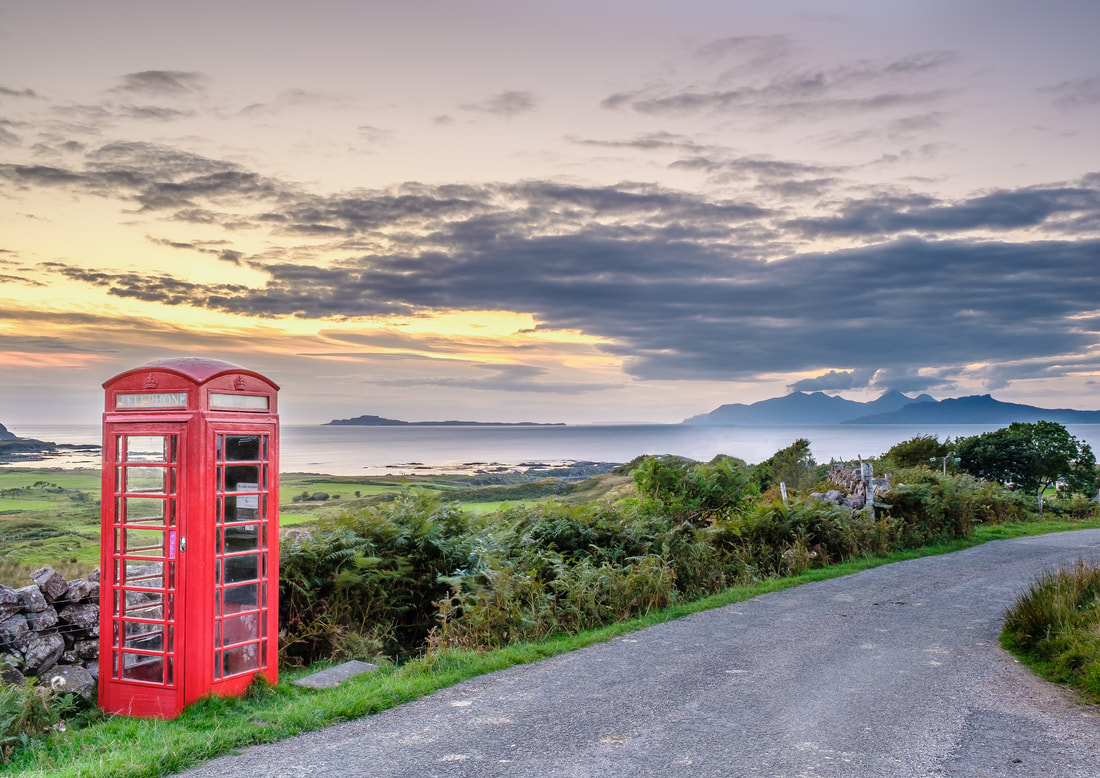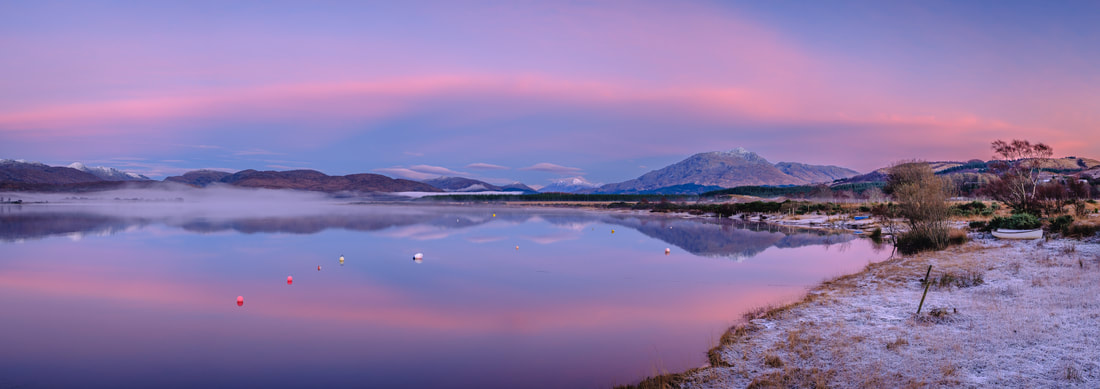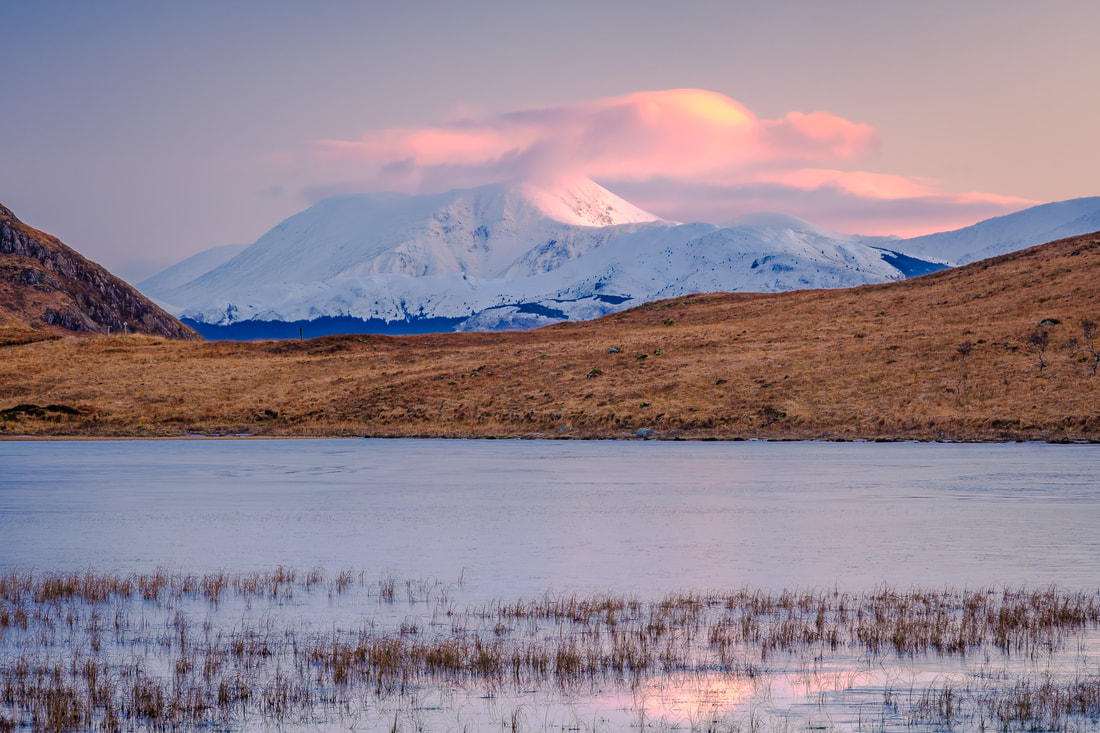|
I been looking through my library of images in recent weeks, looking for common themes that might form the basis of a couple of projects for the next 12 months or so and noticed that there were a few photographs that were taken during what is called the “Blue Hour”, an incredibly photogenic time of the day when the landscape is infused with rich, blue tones. One of these images is below and it shows Ardnamurchan Lighthouse on its rocky promontory with the sea, the land and the sky all tinged with these rich, blue tones. So what exactly is the blue hour? The blue hour occurs twice a day, just before sunrise and just after sunset, so you might be thinking that it is simply the time of day known as twilight, but there is a little more to it than that. This first thing to know is that there are three phases of twilight: civil twilight, when the Sun is between 0° and -6° below the horizon; nautical twilight, when it is between -6° and -12° below; and astronomical twilight, when it is between -12° and -18°below. During civil twilight, there is still colour in the sky, and it is light enough to see objects clearly; the sky is darker during nautical twilight and by astronomical twilight it's almost completely dark. The evening blue hour is the period of transition from civil to nautical twilight (or vice versa in the morning), when the Sun is between -4° and -8° below the horizon. At this time, the longer red wavelengths of light from the Sun pass straight out into space and the shorter, blue wavelengths are scattered in the atmosphere. The result is a rich and saturated cool blue colour that is incredibly atmospheric, so if romance and mystery are your thing, this really is a great time head out with your camera. Before you do though, you should know that despite its name, the blue hour only lasts for 20-40 minutes depending on your location, the time of year and atmospheric conditions. At this time of year here on the Peninsula, it begins at about 20 minutes after sunset and at 45 minutes before sunrise. In either case it lasts for around 20 minutes, so the opportunity for photography is fleeting, but nonetheless very rewarding. Beyond its aesthetic appeal, I find the blue hour to be an incredibly tranquil and thought-provoking time of day, and this is especially true of the evening blue hour. I’m not sure what it is, but this “in-between time” during which day transitions into night, I feel compelled to pause and appreciate the beauty of that exact moment. This is especially true if I’m out in the landscape alone with my camera because moments of such solitude bring a real sense of peace and stillness that allow me to disconnect from any stresses or challenges that I may have experienced during the day.
As the blue hour comes to an end, the sky transforms from the canvas of rich blues that I was photographing to a deepening shade of indigo. With this comes the gradual unveiling of the stars, with each one sparkling ever brighter as the sky darkens. As more and more stars become visible, I am often struck by the vastness of the cosmos and with this comes strong feelings of awe and humility due to Earth’s true insignificance. The sheer scale of the Universe, with its billions of galaxies each containing billions of stars, puts into perspective the minuscule size and fleeting existence of our home planet. It is a mere speck of dust in the cosmic ocean and seems so inconsequential in comparison to the unimaginable expanses of space stretching out in all directions. It is in these moments that I am reminded of the transient nature of human existence. Yet, amidst this feeling of smallness, there is also a sense of wonder and curiosity. The very fact that we can contemplate our place in the Universe, that we can marvel at the stars and ponder the mysteries of existence, is a testament to the extraordinary capabilities of the human mind. It is in moments like this that I just love catching the blues.
0 Comments
I took the image below on a late February afternoon from the sandy beach at Port na Carraidh at the western end of the Ardnamurchan Peninsula. Like many of my landscape images, the process involved finding the composition, framing the shot and then a significant period of time waiting for the light to be right. While some people may find such time boring and perhaps frustrating, I find it to be one of the most enjoyable parts of the whole process because it provides an opportunity for some quiet reflection and thinking which, on this occasion, had me pondering the difference between knowledge and wisdom. I guess I ended up thinking about the difference between the two because photography, as both an art form and a technical skill, involves a delicate balance between knowledge and wisdom. Indeed, a photographer’s ability to capture compelling images is influenced not only by technical know-how but also by the nuanced application of wisdom.
Knowledge in its fundamental form is gained by the acquisition of information, facts, and skills which, in the case of photography, encompasses an understanding of things such as camera settings, composition rules, lighting techniques, and post-processing tools. It is the photographer's proficiency in handling equipment, choosing the right exposure, and manipulating elements within the frame that provides the necessary foundation for capturing technically sound images. In contrast, wisdom goes beyond the mere possession of such information and the technicalities of taking a photograph. It allows photographers to determine the relevance of various pieces of the information that make up their knowledge and how best to apply it to their own work. To my mind, a wise photographer understands that a compelling image is not solely about pixel-perfect technical execution but about conveying a story, evoking emotions or capturing the essence of a moment. One key distinction between the two lies in how they are acquired. Knowledge can be obtained through formal education, reading and observation. It is quantifiable and can be measured in terms of proficiency in a specific field or the retention of factual details. I’m sure everyone will remember dreaded exams at school that aimed to do just this. Wisdom, on the other hand, is cultivated over time and often matures through a combination of life experiences and introspection, and a willingness to learn from both successes and failures. It certainly can’t be measured in a way that knowledge can be. When thinking about the image above, my sense is that wisdom encouraged me to make thoughtful decisions about what to include in the frame and what to exclude from it, it helped me recognise the emotional impact of light and encouraged me to wait the time I did to take the photograph. The result was that I pressed the shutter button just when the conditions were right and created an image that conveyed the emotions that I wanted it to. In my photographic journey, like many people I guess, I began it by acquiring knowledge through learning the basics of composition, exposure, and editing techniques. It was only after I understood these basics that I was able to practice, try photography under different conditions and, probably most importantly of all, learn from my successes and failures. Recently, I have been reviewing images that I took a few years ago, and comparing those that invoke some form of emotional response with those that don’t. By doing this, I’m working on identifying recurring themes, styles, and subjects that resonate with me. My hope is that by incorporating these elements into my future work, I can refine my artistic style and more consistently create images that resonate deeply with not only myself, but also audiences that view them. Have you ever found yourself wandering in a place where you feel as if you are walking a fine line between this world and another? I ask because it is a feeling I often have when walking among the ancient oaks and between the moss-covered boulders of Ariundle Oakwood. I don’t know what it is about the place, but I feel that I am never too far away from the mystical realm inhabited by the faeries that gives the nearby village of Strontian or Sròn an t-Sìthein (nose of the fairy hill) its name. In my mind, it is one of the “thin places” that can be found here on the Peninsula. The concept of “thin places” has been woven into the tapestry of Celtic folklore and spirituality for centuries, being used to describe places where the boundary between the physical world and a mystical, historical or spiritual world is believed to be exceptionally thin, thus facilitating a sense of connection between the two.
In thin places, you might feel a sense of awe and heightened awareness of being in the presence of something greater than yourself and, as such, they are often characterised by an otherworldly atmosphere, where the ordinary and the extraordinary intermingle. This is certainly something I can say about Ariundle Oakwood, a place where each ancient tree and each moss-covered boulder seems to harbour mystical beings waiting to be unveiled. When you stand in a thin place you may instead find your imagination ignited by thoughts of what has been before you. This historical imagination can transport you to a different era, picturing scenes from the past as if they were unfolding right before your eyes. Camas nan Geall is a place where I get this feeling. This “Bay of the Strangers” is a fascinating place because it contains evidence of human presence that covers a period of several millennia of human history. This ranges from a Neolithic chambered cairn to deserted clearance dwellings and includes a number of things in-between. The chambered cairn in the centre of the bay may seem quite innocuous, but when you stand next to it and consider that people buried their dead there some 5000-6000 years before, you cannot help but feel a sense of what has gone before. Perhaps more poignant though, are the ruins of Torr na Mòine up on the slopes of Ben Hiant which was the settlement that was the home to the people of Camas Nan Geall before they were forcibly evicted in the 18th century so that the land could be used for a sheep farm. It’s hard to comprehend the hardship and trauma that these people suffered from being suddenly cleared from their ancestral lands by the landowner for primarily economic reasons. Finally, the Old Parish Church in Kilchoan is a place where I feel that there is a thin veil between our physical world and the spiritual world. It is a hauntingly peaceful place that seems to compel you to tread carefully and with due deference to ground that has played host to a place of worship from some 700 years. Giving Kilchoan its name, this Church of St Comghan must have been incredibly important to the local community as a place where they could come together not only to worship but to also seek fellowship and support. Indeed, a walk around the graveyard that surrounds the church to look at gravestones that date from as far back as the 14th century and as recent as the 1990’s, pays testament to just how long this “thin place” has provided spiritual succour to the community. There are many other places on the Peninsula to which I have felt a sense of the mystical, historical or spiritual and this most likely stems from my photography encouraging me to slow down and take time to get a real sense of a place before I ever think of pressing the shutter button. However, you don’t need a camera to experience the profound ways in which certain locations can inspire feelings of connectivity to a different realm. You can just slow down, look, listen and feel when you next find yourself in a place that you sense you might be connected to. In today’s world of smartphones and digital cameras, photography has become more accessible than ever before, and we see social media full of images of places and events that people have chosen to share. It is fantastic that people can capture these images with a simple click of a button, but this act of taking a picture is quite different from the art of making a picture. It’s something I’m very aware of when making images such as the one below, which shows one of the most spectacular sunsets I’ve ever seen out at Ardtoe. This is because, in such moments, I’m not only trying to capture what my eyes saw, but also what my heart felt. For me, taking a picture refers to the act of quickly capturing a moment, scene, or subject without much thought or consideration. It can be spontaneous, casual, and primarily focused on preserving memories or documenting an event. The emphasis is on the subject itself rather than the photographer's creative interpretation. In this sense, taking a picture is often associated with casual photography, such as snapshots, selfies, or everyday moments captured on the go.
On the other hand, making a picture is a deliberate and intentional process in which the photographer uses their technical and creative skills to transform a scene or subject into a visually compelling image. The focus shifts from simply recording what is in front of the camera to crafting an image that conveys a specific message and evokes certain emotions. When taking a picture, you typically rely on the automatic settings of a camera or smartphone, allowing the device to make decisions about technical aspects such as exposure and focus. The priority is to capture the moment quickly and efficiently. In contrast, making a picture often involves a more involved manual approach, where you take control of the camera settings to achieve a desired aesthetic. In landscape photography, this typically involves selecting the right lens and focal length; adjusting the aperture, shutter speed and ISO; and reading the weather and light conditions to determine the best place and time to press the shutter button. Taking the image above as an example, I planned and made repeated visits to a particular spot at Ardtoe at this time of the year because I knew that I would see the Sun setting behind the Isle of Eigg from there. The specific days on which I made these visits were determined by the weather conditions, with me looking for low cloud directly overhead and gaps in the clouds on the western horizon through which light from the setting Sun would shine. I chose a lens with a long focal length, that would bring the distinctive silhouette of An Sgùrr on Eigg closer to the skerry of Sgeir an Eidigh. I set the aperture so that both would be in focus because they were key elements of the story. I set the ISO and shutter speed to let the correct amount of light into the camera when using a long exposure time to smooth out the sea so that it would not detract from these key elements. Finally, I waited with great anticipation for the rays of light to break through the clouds and light up An Sgùrr to create the perfect moment to press the shutter button. It was only then that I was able to make the image that I had in my mind’s eye. A simple but distinctive image that conveyed the dramatic beauty of a mid-summer sunset that featured the unmistakeable profile of An Sgùrr on the Isle of Eigg. So, although both picture taking and picture making have their place in photography, it’s the latter that I find the most satisfying. You have to be prepared for disappointments and failures along the way, but with planning, patience, and persistence, you will be rewarded with images that go beyond mere documentation to capture and evoke the emotions you felt at the precise moment you pressed the shutter button. I would never have thought that a seemingly innocuous slip on a wet rock at Ardtoe would have resulted in a debilitating injury requiring surgery, 4 months of immobilisation, 12 months of physiotherapy and a further 6-12 months of recovery time to get me back to a point where I can freely walk in and photograph the landscape here on the Peninsula. However, this was indeed the case, and I am thankful that I had my photography to use as the motivator to get active and aid my recovery. It also resulted in the creation of a collection of 72 images that portray the varying landscape and moods of the Peninsula throughout 2022. This blog contains 12 of these images, one for each month of the year, and I hope to share the remainder of them over the course of 2023. The BackstoryOn 6th July 2021, I slipped on some wet rocks at Ardtoe, dislocating my knee and tearing my patellar tendon in two. Following an operation to repair the damage, I found myself immobilised and in a knee brace until early November and unable to get out and do any photography. While laid up in the brace, I set myself the target of getting back out with the camera by the start of 2022 and the objective of taking 5 or 6 images each month that captured the varying landscape and moods of the Peninsula throughout the year. With limited mobility, especially at the start of the year, I had to think carefully about locations I could safely go that would provide me with opportunities to take the photographs that I had in mind. This was a bit of a challenge at first, but I found that this limitation helped me with my creativity. By the end of the year, I had visited enough locations and taken enough photographs to enable me to create a collection of 72 images, or six for each month to reasonably portray the Peninsula over the course of 2022. Twelve of these images, one for each month, are presented in this blog and I plan to share the rest of them over the course of the coming year in a new section on this website titled “A Year on the Peninsula”. As well as the collection of images, the project provided me with the motivation to get “out there” and get back into my photography and aid my recovery. When pulling these images together, I was certainly reminded of how far I have come since that day in January when I gingerly made my way down the jetty at Salen with the help of a crutch to take the first photograph in this collection. I still have a number of months left in my 18-24 month long recovery period and hopefully, as my ability to walk on uneven ground and also downhill improves, I’ll be able to range further afield and photograph locations that I have not been able to get to since that fateful day in July 2021. The ImagesAnticipation I - Loch Sunart, Salen Jetty, Ardnamurchan
I started the year with some early morning visits to the old jetty in Salen because in January, the sun rises well round to the south-east and is able to cast beautiful light and colours onto the waters of the bay and the jetty itself. On my final morning, the sun seemed to take an age to appear from behind the hills of Morvern, but it was well worth the wait. Distant Lighthouse I - Port na Carraidh, Ardnamurchan
Mid-February brought Storm Eunice along with its record-breaking winds and widespread disruption. The day after the Storm had passed, I headed out to Port na Carraidh at the western end of the Peninsula with the aim of photographing a distant view of the Lighthouse and after much searching I settled on this composition that used the stream on the sandy beach to lead the eye out to it. Tioram and the Zodiac - Castle Tioram, Dorlin, Moidart
In March, the Zodiac rises steeply from the horizon at dusk, making it a great time for spotting Zodiacal Light. Caused by light from the sun reflecting off a fog of tiny interplanetary dust particles that fill our inner Solar System, it shows as a faint triangular glow rising steeply from the western horizon just like in this image I took at Castle Tioram. Light on Risga - Loch Sunart, Glenborrodale, Ardnamurchan
This shot was taken on an April morning when I was driving back home from an overnight photo session out west. As I approached Glenborrodale, the first light of the day was falling on the island of Risga, the skerries around it and Carna behind it. A sight that was simply too beautiful to not stop and photograph. Caisteal nan Con I - Bagh Caisteal, Killundine, Morvern
Caisteal nan Con (Castle of Dogs), overlooks the Sound of Mull on the eastern coast of Morvern. I have passed it a few times on trips out to Drimnin and it has always caught my eye, so I decided to stop when passing it late on an evening in May and photograph just as cloud was rolling in from the west and catching the pinks from a setting sun. Day's End, Land's End - Ardnamurchan Lighthouse, Ardnamurchan
Three days after the longest day of the year, in late June, I was out at the lighthouse for its 25th anniversary of community ownership. The day had started with wind and rain but the afternoon cleared and I decided to capture the day’s end a good few hours after the anniversary celebrations ended. The sun set in the northwest shortly after 10:00 pm. Sundown Blues II - Sailean Dubh, Ardtoe, Ardnamurchan
A “must do” thing to do in July is to watch the sun set directly behind the Small Isles of Eigg and Rùm from the headland on the western side of the beach at Ardtoe. I had spent a very peaceful time doing just that in the couple of hours before I took this image of the blues of the emerging blue hour mixing with the golds of sunset. Return of the Stars - The House Pool, River Shiel, Blain, Moidart
In August, the lengthening nights mean the return of stars and up until early October, you can marvel at the sight of the Milky Way filling the sky with a cloudy band of stars. This image shows it soaring above the House Pool on the River Shiel on a night in late August when I must have seen around a dozen shooting stars from the Perseid meteor shower. Harvest Moon Reflections - Ardtoe Pier, Kentra Bay, Ardnamurchan
In September, the full Moon rises in the southeast and if you watch it from Ardtoe Pier at the western end of Kentra Bay, it will appear above a distant Ben Resipole and cast reflections onto the water in the bay as it does so. In 2022, it was the nearest full Moon to the autumnal equinox, earning it the title of 'Harvest Moon'. Lilac Dawn - Loch a' Choire, Kingairloch, Ardgour
Loch a’ Choire is at the heart of Kingairloch Estate and in October the Sun rises in line with its east facing entrance and can create some beautifully vibrant sunrises there. I had hoped to capture one of these sunrises on the morning I was there, but haze and cloud on the horizon subdued it and instead created some lovely lilac hues on the loch’s surface and in the sky above it. Two Bridges - River Shiel, Blain, Moidart
The 2.5-mile-long River Shiel flows from Loch Shiel to the sea and forms part of the boundary between Moidart and Ardnamurchan. It can be crossed by either of the two bridges shown in this image which was taken on a November afternoon when the light bathed the autumn-coloured trees on the Moidart side it. Ben Resipole can be seen in the distance. A Year Ends - Kentra Bay, Gobshealach, Ardnamurchan
Early December brought clear blue skies and sub-zero temperatures which were followed by two weeks of milder weather, wind and heavy rain. Fortunately, this broke for a little while on New Year’s Eve to allow me to capture dusk falling on the mouth of Kentra Bay as the end of the year approached. The Small Isles of Muck, Eigg and Rùm are in the orange glow on the horizon. Despite living on the Peninsula for several years now, it still often feels like it is a world away from the rest of the country and it is little wonder that summer brings a steady stream of visitors seeking to experience this beautiful, remote, and unspoilt corner of the Scottish Highlands. I often say to visitors that it has a bit of everything that Scotland has to offer, with rugged mountains, beautiful lochs and ancient woodlands, but it is its dramatic and stunning coastline that holds the biggest draw for me and features most in my photography Take this month’s image, which was shot on a beautifully sunny day in July out at Sanna, looking north across the bay to the Small Isles beyond. On days such as this, with bright sunlight overhead, the sea takes on an intense range of blue hues ranging from light blues of the shallow water to the dark blues of the deeper water, all caused by the way light interacts with the seawater.
You see, daylight is made up of many different visible colours, ranging from reds and oranges to blues and violets, with the reds and oranges having the longest wavelengths and the blues and violets having the shortest. As water molecules are better at absorbing light with longer wavelengths, they absorb much of the red, orange, yellow and green light. The bluer colours, with shorter wavelengths, are less likely to be absorbed and so are reflected by the white sand on the seabed to give the sea its blue hues. In shallow water, there are fewer water molecules to absorb the red, orange, yellow and green light, so more of it reaches the seabed to be reflected with the blues and violets and give either clear or slightly blue water. However, the deeper the water becomes, the more the reds, oranges, yellows and greens are absorbed and the deeper blue the colour of the water becomes, until you reach the point where no visible light can reach the seabed and the water becomes completely dark. I find something quite captivating about the aquatic blue hues of the sea at places such as Sanna and I’m sure that this is reflected in my affinity for water and for photographing the sea and the coastline. In fact, it has been documented that our affinity for water is reflected in our near-universal attraction to the colour blue and that we associate this colour with qualities like calm, openness, depth and wisdom. The link between the two has even been developed into something called “Blue Mind Science”, the study of aquatic environments’ health benefits that was first popularised by marine biologist Dr Wallace Nichols in his 2014 book, “Blue Mind”. Simply put, Blue Mind is a mildly meditative state that people fall into when they are near, in, under or on water and some of the physical and mental health benefits include:
So, if you’re seeing red, feeling angry, anxious, and stressed, then head to the coast for some “Blue Mindfulness”. I can highly recommend it. There’s something magical about watching the beginning of a new day, especially on mornings as perfect as the one when I took the photograph below from the hills above Acharacle while looking north-east over Loch Shiel to Ben Resipole and the distant peaks of Ardgour beyond. Although it is only a short climb, the view you get from up there is simply amazing and this makes it one of my most favourite places to do one of my most favourite things, which is to watch a sunrise. I’m a morning person and naturally wake up early, but I do realise that not everyone is like this. Therefore, I thought that I’d give some reasons why I think it is good to at least once, get up early with the birds, head to a favourite place and watch a new day begin:
Views of the Small Isles of Muck, Eigg, Rùm and Canna are ever-changing as you make the journey from east to west along the coast of Moidart and north Ardnamurchan and past its spectacular cliffs, dramatic rocky shores and beautiful white sand beaches. While the dramatic peaks of Rùm’s Cuillin Mountain range are ever present, the distinctive profile of Eigg and its highest hill, An Sgurr, is a prominent feature at first, but it gradually disappears from view to be replaced by the more diminutive profile of Muck as you reach the journey’s end……. IntroductionScotland has 40 National Scenic Areas which cover 13% of its land mass and they earn this designation because their outstanding scenery makes them the country’s finest Landscapes. One of these areas is Morar, Moidart and Ardnamurchan here on Scotland’s north-west coast. It is home to a coastline of spectacular cliffs, dramatic rocky shores and beautiful white sand beaches. Added to all of this are breath-taking views of the Small Isles of Muck, Eigg, Rùm and Canna, which sit a few miles west out in the Sound of Arisaig and just south of the Isle of Skye. As you travel from Moidart in the east, to Ardnamurchan in the west, your perspective of the Small Isles changes significantly, with both them and features on them coming into view and disappearing again after only a few miles. This everchanging view makes photographing both them and this coastline an absolute joy and now that the evening sun is in the north-west, my plan for the coming weeks is to photograph to do just that. My aim is to capture this spectacular coastline while it is bathed in warm sunlight at the end of our long summer days. In the meantime, however, I thought I would describe this somewhat special journey and share some of the images that I already have. Moidart
On reaching Glenuig, you can turn off the main road, drive past the Glenuig Inn and continue westward for about a mile and a half to reach the road end. From there, a short walk takes you to Smirisary, an isolated and roadless crofting village that sits between a rocky foreshore and a steep hillside about two miles to the west of Glenuig. As you walk the final half mile to the village, your view of the sea is obstructed by a small hill, but as you get to the top of it, the view dramatically opens up to reveal islands that you feel you can almost touch (Image 3). I like to visit Smirisary in mid to late summer. It is a great place to capture Muck, Eigg and Rùm sitting in flat calm seas while they are silhouetted against the colourful skies that are a feature of the sunsets there at that time of year. From there, you get a closer view of the distinctive shape of An Sgurr and the dramatic peaks of the Rùm and its Cuillin mountain range, which sits behind Eigg and simply adds to the magic you are witnessing (Image 4).
East ArdnamurchanIf you want to get a view of the Small Isles on this part of your journey, you need to head out to the small but beautiful sandy beach at Ardtoe where a short walk out to the headland on its western side brings the southern end of Eigg and An Sgurr back into view. From there, you also get a glimpse of Rùm because the high peaks of the Rùm Cuillin are just visible above the land that shelters the beach from the open sea (Image 1 and Image 7). While at Ardtoe and if you don’t mind a walk over uneven and often boggy ground, you can make your way out to the end of Rubha Luinngeanach where you get a more open view of Eigg with Rùm behind it. It was at this spot where I witnessed what I think is the most spectacular sunset I have ever seen over the Small Isles (Image 8). I was out there on a rather cloudy July evening, so my hopes of getting a good image were not high. Suddenly the clouds beyond the skerry of Sgeir an Eidigh parted and allowed the most intense of crepuscular rays to shine down on the Isle of Eigg and silhouetted it against the golden backdrop that they had created. It is a moment that is forever etched on my memory. On leaving Ardtoe to head back towards Acharacle, you’ll find that a slight diversion down the road towards Arivegaig rewards you with a fine view out through the entrance of Kentra Bay to Eigg, where An Sgurr sits directly behind the gap between the land and the sea (Image 9). The road to Arivegaig is also a spot where you can catch a full moon setting behind the Rùm Cuillin on a clear winter morning (Image 10). West ArdnamurchanThe next part of the journey west takes you along the side of Loch Sunart and it is a good few miles before you see the Small Isles again because the road now takes you along the southern coast of the Ardnamurchan Peninsula. It is not until you pass Camas nan Geall and follow the road north around the side of Ben Hiant to reach Doire Daraich before they come back into view again (Image 11). Given how far west you have travelled to reach there, the perspective is now very different because Eigg now sits to the right of Rùm, while the drive down to Kilmory brings the Muck back into view as reach the phone box just before the village (Image 12).
It is from the hills above Portuairk from where I think you get the most dramatic view of Rùm and the magnificent peaks of its Cuillin mountain range. It is simply majestic, sitting there beyond Sanna Bay and the significantly more diminutive Isle of Muck (Image 15). While there, it is well worth taking the walk from Portuairk to the beautiful white sand beach at Sanna because, as you climb over the hill that separates the two, another magnificent view of the Small Isles reveals itself (Image 16). It is from there that you can see all the Small Isles because the fourth and, up until now, elusive Isle of Canna reveals itself. If you stop there for a little whole and look north over the beach you can just make it out, sitting well out the west of the Isle of Rùm, which has Eigg to its east and Muck to its south. Journey’s EndOur journey from east to west along this beautiful Moidart and Ardnamurchan coastline ends at Ardnamurchan Point. It is as far west as you can go on the British Mainland and is home to the iconic Ardnamurchan Lighthouse which so many visitors head for when they visit the West Highland Peninsulas.
While you do get a clear view of the Small Isles from there, they do not readily sit in any photographic composition that features the lighthouse because the camera tends to point in a direction looking away from them or is at an angle where the islands are hidden by the lighthouse itself. It takes a walk out on to the rocks of Dubh Rubha Mor at low tide before you can point the camera north, across the bay of Briaghlann, and capture both the lighthouse and the now familiar profile of Rùm and Muck behind it and it seems fitting that I end this journey with an image of the sun setting on this very scene (Image 17). We’re coming to the end of this winter. One during which we had the coldest January since 2010. One of snow and of cold and clear weather and one that has been productive from a photographic perspective. See some of the images I’ve captured and find out a bit about the story behind them…. How Do You Cope with all the Snow?We are fast approaching the start of Meteorological Spring (March, April and May) and also the end of my fifth winter since moving to the Peninsulas. There is a noticeable difference in the hours of daylight as the nights shorten and it will not be long before the landscape begins to spring back into life. I find myself thinking back on the winter months of December, January and February; and also a question I’m often asked by people visiting – “How do you cope with all the snow in winter?” Why this question gets asked always intrigues me. It seems to always happen when standing on the decking outside my studio looking at Loch Sunart and all the hills that surround it. Could it be because this remote and rugged landscape looks foreboding? Could it be because we are well north of where most people live? Who knows? Well, whatever it is, my answer is always the same - “It’s never a problem here as we don’t get that much snow and when we do get it, it is usually only high up on the hills. In fact, if the snow does fall down here at sea level, it only lasts a day or two at the very most and I guess that being on a bit of land that sticks out into the sea on the west coast means that the Gulf Stream keeps the temperatures up”. This is indeed true and it is complete contrast to the snowy winters I experienced when growing up on the east side of Scotland when, in the days without central heating, thick frost would form on the inside of the windows and we’d need to scrape a little hole in it to reveal what was outside. I do miss “proper” winters like that, but looking back over the last few months, it certainly feels as if we’ve had one this time. In fact, we’ve just had our coldest January since 2010, with the average temperature recording in Scotland being 0.6°C while my weather station here at Resipole recorded an average of 2.9°C. The strong northerly air flow that brought the low temperatures also brought substantial sunshine with it and plenty of cold, crisp and clear days on which I just had to get out with the camera. First Snow and Winter InspirationLooking back through my images from the last few months reminded me that this “proper” winter weather was not just limited to January. Indeed, we saw our first snow at the end of November while having a staycation at Kingairloch Estate over on the east side of the Peninsulas. We woke up on a morning towards the end of our week away to see snow on the distant high peaks of Glencoe and the Mamores. This prompted a drive up the shore of Loch Linnhe to get a closer look. The snow-capped mountains looked lovely under the clear blue sky and we just had to stop at Lochan Doire a' Bhraghaid to take in the view. From there you get a fantastic view of Ben Nevis because you can see it through a gap in the hills above Inversanda. While there, I took this shot of the snow-covered slopes of Ben Nevis, some 17 miles to the north and made a mental note to myself to come back at some point and capture it when it had the first light of a winter day on it. Searching for Some LightThis first of the winter snow on the hills lasted for just over a week, but before it disappeared, I headed to West Ardnamurchan and up to a spot high on the slopes of Beinn Bhuidhe above Glenmore. It’s a great place to capture panoramic views of Loch Sunart or use a long lens to not only pick out elements of the high hills of Morvern on the other side of Loch Sunart, but also of Loch Teacuis, which cuts its way southwards into them. Unfortunately, I always seem to time my visits to the slopes of Beinn Bhuidhe on days when the light does not want to do what I need it to do. I’ve lost count of the number of times I’ve left Resipole under promising looking skies only to arrive at my spot and find thick cloud and no light on the landscape. I thought that this time was going to be another like that because thick cloud greeted me on my arrival. As I followed the path up to Beinn Bhuidhe, I kept looking at the cloud filled sky in the hope that it would clear a little and let through some light, but it didn’t. Undeterred, I set up at my chosen spot and sat for about an hour, sheltering as best I could from the biting easterly wind, while looking through the long-lens I’d fitted to the camera in search of some compositions that might work if the light did appear. I had almost given up hope, but in the few minutes before the sun was due to dip below the hills to the south-west, a small gap appeared to let a patch of light fall on the snow-capped peak of Beinn Iadain, one of the high peaks of Morvern. The resulting image shows the peak of Ben Iadain sporting a crown of golden light with the north facing slopes of Beinn Ghormaig, the Isle Carna and the Isle of Risga sitting in front of it. An Afternoon of SerendipityThankfully, not all my shots are so hard won and occasionally good fortune smiles on me. In early December, a few weeks after my time on Beinn Bhuidhe, I had a batch of Christmas orders to take to the Post Office in Acharacle and while packing them all into the car, I could not help but notice some hints of colour appearing in the sky to the west. It looked promising, so I decided to take my camera gear with me just in case. I sure wasn’t disappointed with what unfolded. As I drove down into the village, I could see the mist beginning to form in the air above Loch Shiel, so instead of going straight to the Post Office, I took the short detour down to the jetty in village to check out the conditions on the loch. As I stood on the jetty, I watched the pinks and purples of a winter sunset intensify while mist rolled down the loch and I couldn’t help but feel an overwhelming sense of calm, as well as whole load of good fortune about my decision to take my camera gear with me. I was there for well over an hour, photographing scenes in different directions and under different light conditions before deciding that I really needed to get to the Post Office before it closed. Both jobs done. Parcels posted and a number of “keepers” captured including this panoramic image of the sunset colours at their peak. A Plan Comes TogetherFinding myself in January and in a new year, my mind was still set on capturing the shot of the first light of the day on the snow covered peak of Ben Nevis. The shot that I had thought of when I saw the first snow of this winter on the hills back in November. With clouds usually covering its summit for nearly 80% of the winter months, photographing Ben Nevis sure turned out to be a bit of a wating game. There needed to be a clear morning during a spell of the weather cold enough to put snow on the Ben and freeze the surface of Lochan Doire a' Bhraghaid. Finally, at the start of the second week in January, the conditions seemed very promising and I headed up into the hills above Inversanda for sunrise in the hope that I’d get the shot I was looking for. Setting up in the dark, I couldn’t see if Ben Nevis was clear of cloud, but the moon and stars above my head suggested that it could be. As I waited for the first light of what was a very cold January morning to appear, the mountain began to emerge from the darkness and it looked as if my luck was in. Eventually, the first light of the day shone on its south facing upper slopes and there was just enough cloud to enhance the pink of the sunrise which, even at a distance of 17 miles, was reflected back onto the frozen surface of the lochan. I love it when a plan comes together. Time for a Plan BThe last week in January brought a few days of very heavy snowfall which, very unusually left a couple of inches of the white stuff all the way down to the seashore. Equally unusual were day and night-time temperatures so low that the snow at sea level did not disappear. As I watched successive tides wash fresh falls of snow from the loch shore, I thought that an image of snow lying on a sandy beach all the way down to the water would be worth capturing and that the beach at Ardtoe would be a great place to do it. With this in mind, I awoke early on a morning after heavy overnight snow had been forecast. On opening the curtains to a freshly snow-covered landscape, I decided to head out to Ardtoe. With much anticipation, I left the house but as I drove closer and closer to my destination the clear skies became more and more obscured by mist. This is not unusual because the low ground around Loch Shiel often cradles mist on cold and still winter mornings. So undeterred, I continued my journey to the beach as experience suggested that it would be clear there. However, it was not to be and I was greeted by a snow-covered beach shrouded in thick mist. The more I waited for the mist to clear, the thicker and thicker it seemed to become, so I eventually decided to head home. On the drive back through a beautiful snow-covered landscape, I thought that the conditions were too good to submit to failure and began racking my brains to figure out a place where a combination of misty conditions and fresh snow fall could work together. I eventually decided to take a small detour to the old bridge over the River Shiel at Blain to see what it was like there. When I arrived, I was not disappointed. The scene was stunning with all the trees covered in the freshly fallen snow and some beautiful light fighting its way through the mist behind the bridge. After an extremely productive half hour, I left with a few images, including this one of the bridge, with the river beneath it coloured by golden light fighting to break through the mist behind it. Thank heavens for a little local knowledge and for figuring out a Plan B. A Winter I Will RememberIt’s been a winter just like the ones I remember from my childhood. I’ll remember it not only for its snow and its cold, clear days but also for it being a winter that has given me an extremely productive time for my photography. The images I’ve included in this blog are just a small sample of those that I’ve captured and if you’d like to see more, you can find the in the Recent Images Gallery on this website. I hope you enjoy them.
|
AuthorHi, Archives
April 2024
Categories
All
|


